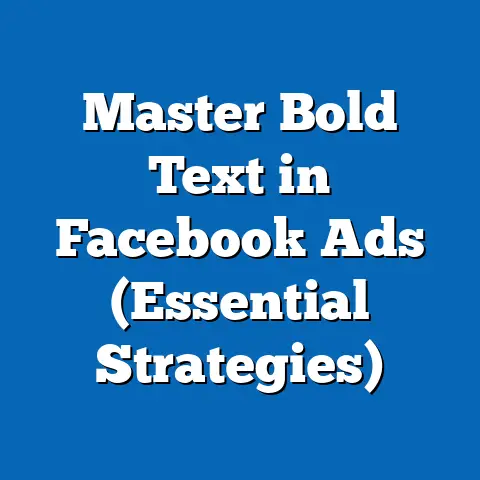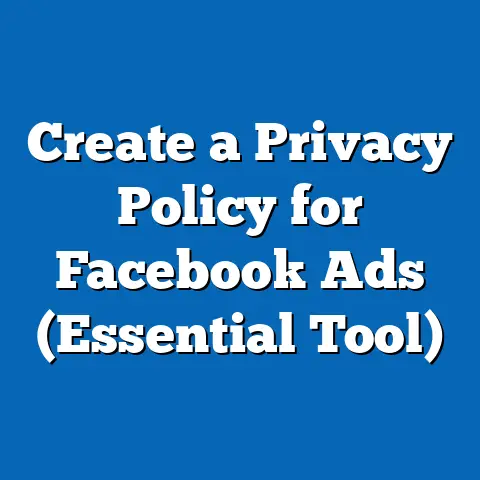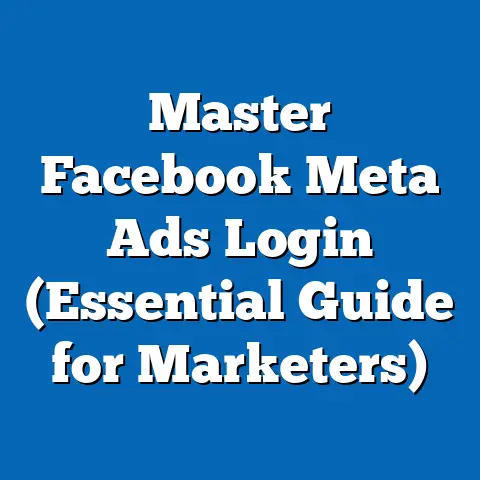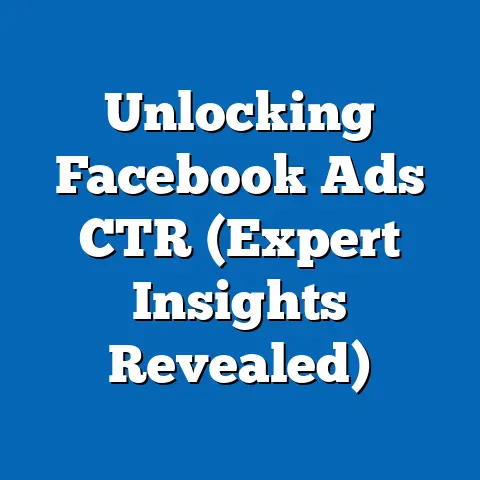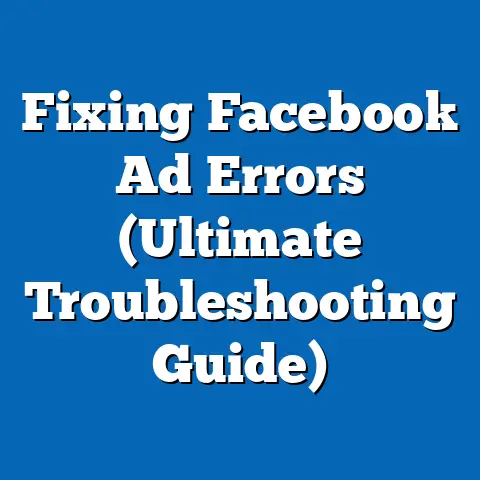Stop Facebook Ads Hassles (Ultimate Guide for Marketers)
Let’s face it, diving into the world of Facebook Ads can feel like plunging into a chaotic ocean. I remember my first attempt – armed with enthusiasm and a burning desire to boost my (then fledgling) online store, I envisioned a seamless stream of targeted traffic. What I actually got was a confusing maze of ad policies, a budget that vanished faster than a free sample at Costco, and a whole lot of head-scratching trying to decipher the data. Sound familiar?
You’re not alone. Many marketers and business owners start their Facebook ad journey with high hopes, only to be met with a frustrating reality. The platform’s potential is undeniable – reaching billions of active users with laser-like precision is incredibly appealing. But the sheer complexity of the system, the ever-changing algorithms, and the pressure to stay compliant with evolving ad policies can quickly lead to overwhelm and, frankly, a lot of wasted money.
Facebook Ads can be a powerful tool for explosive growth, increased brand visibility, and highly targeted conversions. But the associated hassles – the learning curve, the constant monitoring, the potential for ad disapprovals – often leave marketers feeling burnt out and questioning their investment.
Section 1: Understanding Facebook Ads
Before we dive into the nitty-gritty of troubleshooting and optimization, let’s lay a solid foundation by understanding the fundamentals of Facebook Ads.
1.1 Overview of Facebook Ads
Facebook Ads are, at their core, a powerful way to reach a massive and diverse audience with highly targeted messaging. They’re not just about slapping up a picture and hoping for the best. They’re about strategically crafting campaigns that resonate with specific demographics, interests, behaviors, and even life events.
Think of Facebook as a giant digital town square. Millions of people are scrolling through their feeds every day, connecting with friends, family, and the world around them. Facebook Ads allow you to strategically place your message within that flow, capturing the attention of potential customers who are most likely to be interested in what you have to offer.
Here’s a breakdown of the different types of ads available:
- Photo Ads: Simple and effective, these ads feature a single image with accompanying text. They’re great for showcasing products or services in a visually appealing way.
- Video Ads: Highly engaging, video ads can capture attention and tell a story in a dynamic and memorable way. They’re perfect for demonstrating product features, sharing testimonials, or building brand awareness.
- Carousel Ads: These ads allow you to showcase multiple images or videos in a single ad unit, each with its own headline, description, and link. They’re ideal for highlighting different aspects of a product or service, or for telling a sequential story.
- Collection Ads: Designed for e-commerce businesses, Collection Ads feature a hero image or video followed by a grid of related products. They provide a seamless shopping experience, allowing users to browse and purchase products directly from the ad.
- Instant Experience Ads: These full-screen, mobile-optimized ads offer an immersive and interactive experience. They can include videos, photos, carousels, and even forms, allowing users to learn more about your brand or product without leaving Facebook.
- Lead Ads: Designed to generate leads, these ads allow users to submit their contact information directly from the ad, without having to visit a landing page. They’re perfect for collecting email addresses, building your subscriber list, or qualifying potential customers.
Current Statistics:
- Facebook has nearly 3 billion monthly active users (as of Q1 2024), making it the most popular social media platform in the world. (Source: Meta Investor Relations)
- The average click-through rate (CTR) for Facebook Ads across all industries is around 0.9%. (Source: WordStream)
- Mobile advertising accounts for the vast majority of Facebook’s ad revenue. (Source: Statista)
Key Takeaway: Facebook Ads offer a diverse range of formats to suit different marketing goals and target audiences. Understanding these formats is crucial for crafting effective campaigns.
1.2 The Importance of Facebook Ads for Businesses
In today’s digital landscape, Facebook Ads are no longer a “nice-to-have” – they’re a necessity for businesses of all sizes. Here’s why:
- Unparalleled Audience Targeting: Facebook’s targeting capabilities are incredibly granular. You can target users based on demographics (age, gender, location), interests (hobbies, passions, favorite brands), behaviors (purchase history, online activity), and even life events (new job, recent move, upcoming birthday). This allows you to reach the people who are most likely to be interested in your products or services, maximizing your ad spend and improving your ROI. I’ve personally seen campaigns where refined targeting resulted in a 3x increase in conversion rates.
- Increased Brand Visibility and Awareness: Even if users don’t click on your ad, simply seeing your brand name and logo can increase brand awareness and recognition. Consistent exposure to your brand can build trust and familiarity, making potential customers more likely to choose you when they’re ready to make a purchase. Think of it as planting seeds – the more people see your brand, the more likely those seeds are to sprout.
- Measurable Results and ROI: Unlike traditional advertising methods, Facebook Ads provide detailed data on ad performance. You can track metrics like impressions, clicks, conversions, and cost-per-acquisition, allowing you to see exactly how your ads are performing and make data-driven decisions to improve your results. This level of transparency is invaluable for optimizing your ad spend and ensuring that you’re getting the most bang for your buck.
- Cost-Effective Advertising: While Facebook Ads can be expensive, they’re often more cost-effective than other forms of advertising, especially when you consider the level of targeting and measurability they offer. You can set a daily or lifetime budget for your campaigns, ensuring that you never spend more than you’re comfortable with. Plus, the ability to optimize your ads based on performance data allows you to continually improve your ROI.
- Drive Website Traffic and Conversions: Facebook Ads can be used to drive traffic to your website, where you can convert visitors into leads or customers. By using compelling ad copy and visuals, and targeting the right audience, you can attract qualified visitors who are more likely to take action on your site. I’ve seen countless businesses significantly increase their website traffic and sales through strategic Facebook ad campaigns.
Key Takeaway: Facebook Ads offer a powerful combination of audience targeting, brand visibility, measurability, and cost-effectiveness, making them an essential tool for businesses looking to grow their reach and drive conversions.
1.3 Common Misconceptions
One of the biggest hurdles in getting started with Facebook Ads is overcoming the common misconceptions that surround the platform. These myths often prevent businesses from even trying, or lead them to give up prematurely. Let’s debunk a few of the most prevalent ones:
- “Facebook Ads are only for large companies with big budgets.” This is simply not true. While large companies may have more resources to spend on advertising, Facebook Ads are accessible to businesses of all sizes. You can start with a small budget and gradually increase it as you see results. The key is to be strategic with your targeting and creative, and to continuously optimize your campaigns based on performance data. I’ve personally helped small startups achieve significant growth with just a few dollars a day.
- “Facebook Ads are too complicated and time-consuming.” While Facebook Ads can be complex, they don’t have to be overwhelming. By breaking down the process into smaller, manageable steps, and by utilizing the resources and tools available, you can learn to create and manage effective campaigns without spending hours every day. This guide is designed to help you simplify the process and streamline your workflow.
- “Facebook Ads don’t work for my industry.” This is another common misconception. Facebook has users from virtually every industry and demographic. The key is to identify your target audience and create ads that resonate with their specific needs and interests. Even if you’re in a niche industry, you can still find success with Facebook Ads by targeting the right people with the right message. I’ve seen successful campaigns in industries ranging from medical devices to artisanal cheese.
- “I can just set it and forget it.” This is a recipe for disaster. Facebook Ads require ongoing monitoring and optimization. The platform is constantly evolving, and what works today may not work tomorrow. You need to be prepared to adjust your targeting, creative, and bidding strategies based on performance data. Think of it as tending a garden – you need to water it, weed it, and prune it regularly to ensure that it thrives.
Key Takeaway: Don’t let common misconceptions prevent you from exploring the potential of Facebook Ads. With the right knowledge and strategies, you can overcome these challenges and achieve significant results.
Section 2: Common Challenges with Facebook Ads
Now that we’ve established a solid foundation, let’s address the elephant in the room: the common challenges that marketers face when using Facebook Ads. Understanding these challenges is the first step towards overcoming them.
2.1 Complicated Ad Policies
Facebook’s advertising guidelines are notoriously intricate and can be a major source of frustration for marketers. Ad disapprovals are common, even for seemingly innocuous ads. Understanding why your ads are being rejected and how to avoid these pitfalls is crucial for a smooth and successful advertising experience.
Here are some common reasons for ad disapproval:
- Violating Prohibited Content Policies: Facebook has strict rules against promoting certain types of content, including illegal products or services, discriminatory practices, hate speech, and misleading or deceptive claims. Make sure your ads comply with these policies to avoid rejection.
- Non-Compliant Ad Creative: Your ad copy and visuals must be accurate, relevant, and non-offensive. Avoid using clickbait headlines, sensationalized images, or deceptive tactics to attract attention.
- Misleading Claims or Guarantees: Don’t make unrealistic promises or guarantees about your products or services. Be honest and transparent in your advertising.
- Targeting Sensitive Topics: Be careful when targeting ads based on sensitive topics like health conditions, religious beliefs, or political affiliations. Facebook has specific guidelines for advertising in these areas.
- Landing Page Issues: Your landing page must be relevant to your ad and provide a positive user experience. Avoid using deceptive or misleading landing pages, and make sure your website is secure and mobile-friendly.
How to Avoid Ad Disapprovals:
- Read and Understand Facebook’s Advertising Policies: This is the most important step. Familiarize yourself with the rules and regulations before creating your ads.
- Be Honest and Transparent: Don’t make misleading claims or guarantees. Be upfront about your products or services and their limitations.
- Use High-Quality Ad Creative: Create visually appealing and engaging ads that are relevant to your target audience.
- Test Your Ads Before Launching: Use Facebook’s ad preview tool to see how your ads will look on different devices and placements.
- Appeal Ad Disapprovals: If you believe your ad was unfairly disapproved, you can appeal the decision. Provide a clear explanation of why you believe your ad complies with Facebook’s policies.
Key Takeaway: Understanding and complying with Facebook’s advertising policies is essential for avoiding ad disapprovals and ensuring a smooth advertising experience.
2.2 Budgeting and Costs
Budgeting for Facebook Ads can feel like navigating a minefield. Hidden costs, fluctuating ad prices, and the constant pressure to optimize your spend can be overwhelming. Understanding the factors that influence ad costs and developing a sound budgeting strategy is crucial for maximizing your ROI.
Here are some key factors that affect Facebook ad costs:
- Target Audience: The more specific and niche your target audience, the higher the cost per click (CPC) or cost per thousand impressions (CPM) will be. This is because you’re competing with other advertisers who are targeting the same audience.
- Ad Placement: Different ad placements have different costs. For example, ads placed in the Facebook News Feed tend to be more expensive than ads placed in the right column.
- Ad Quality: Facebook rewards high-quality ads with lower costs. Your ad quality is determined by factors like relevance, engagement, and landing page experience.
- Bidding Strategy: Facebook offers a variety of bidding strategies, each with its own pros and cons. Choosing the right bidding strategy for your campaign goals is crucial for controlling your costs.
- Competition: The more advertisers who are bidding for the same audience and placements, the higher the ad costs will be.
- Time of Year: Ad costs tend to increase during peak seasons like holidays and major events, as more advertisers are competing for attention.
Budgeting Strategies:
- Start Small and Scale Up: Don’t start with a large budget. Begin with a small daily or lifetime budget and gradually increase it as you see results.
- Set Clear Goals and Track Your ROI: Determine what you want to achieve with your Facebook Ads and track your results closely. This will help you determine whether your ad spend is generating a positive ROI.
- Experiment with Different Bidding Strategies: Test different bidding strategies to see which one works best for your campaign goals.
- Monitor Your Ad Performance Regularly: Keep a close eye on your ad performance and make adjustments as needed. This will help you optimize your ad spend and improve your ROI.
- Consider Using a Budget Management Tool: Several third-party tools can help you manage your Facebook ad budget and track your results.
Key Takeaway: Budgeting for Facebook Ads requires careful planning and ongoing monitoring. By understanding the factors that influence ad costs and developing a sound budgeting strategy, you can maximize your ROI and avoid overspending.
2.3 Performance Tracking and Analytics
Measuring the success of your Facebook Ads campaigns is essential for making informed decisions and optimizing your ad spend. However, the vast amount of data available in Facebook Insights can be overwhelming. Understanding which metrics to track and how to interpret them is crucial for improving your campaign performance.
Here are some key metrics to track:
- Impressions: The number of times your ad was displayed.
- Reach: The number of unique people who saw your ad.
- Clicks: The number of times people clicked on your ad.
- Click-Through Rate (CTR): The percentage of people who saw your ad and clicked on it.
- Cost Per Click (CPC): The average cost you paid for each click on your ad.
- Conversions: The number of people who took a desired action after clicking on your ad, such as making a purchase, filling out a form, or subscribing to your email list.
- Cost Per Acquisition (CPA): The average cost you paid for each conversion.
- Return on Ad Spend (ROAS): The amount of revenue you generated for every dollar you spent on advertising.
How to Interpret Your Data:
- Look for Trends: Analyze your data over time to identify trends and patterns. Are your ad costs increasing or decreasing? Is your CTR improving or declining?
- Compare Different Ads: Compare the performance of different ads to see which ones are generating the best results.
- Segment Your Data: Segment your data by demographics, interests, and behaviors to identify your most valuable target audience.
- Use A/B Testing: Test different ad copy, visuals, and targeting options to see what works best.
- Focus on the Metrics That Matter: Don’t get bogged down in vanity metrics. Focus on the metrics that are most relevant to your business goals, such as conversions and ROAS.
Key Takeaway: Performance tracking and analytics are essential for optimizing your Facebook Ads campaigns. By understanding which metrics to track and how to interpret them, you can make data-driven decisions to improve your results and maximize your ROI.
2.4 Managing Multiple Campaigns
Juggling multiple Facebook Ads campaigns can be a daunting task. Keeping track of different budgets, targeting options, and creative assets can quickly become overwhelming. Plus, the risk of ad fatigue – where your audience becomes tired of seeing the same ads – increases when you’re running multiple campaigns.
Here are some tips for managing multiple campaigns effectively:
- Organize Your Campaigns: Use a clear and consistent naming convention for your campaigns, ad sets, and ads. This will help you keep track of everything and avoid confusion.
- Use a Spreadsheet or Project Management Tool: Track your budgets, targeting options, and creative assets in a spreadsheet or project management tool. This will help you stay organized and avoid mistakes.
- Schedule Your Ads: Use Facebook’s ad scheduling feature to schedule your ads to run at specific times of day or days of the week. This can help you reach your target audience when they’re most likely to be online.
- Rotate Your Ads Regularly: Avoid ad fatigue by rotating your ads regularly. Create new ad copy, visuals, and targeting options to keep your audience engaged.
- Use Dynamic Creative: Use Facebook’s dynamic creative feature to automatically generate different versions of your ads based on your target audience. This can help you personalize your ads and improve your results.
- Monitor Your Ad Performance Closely: Keep a close eye on your ad performance and make adjustments as needed. This will help you optimize your ad spend and improve your ROI.
- Consider Using a Third-Party Ad Management Tool: Several third-party tools can help you manage multiple Facebook Ads campaigns more efficiently.
Key Takeaway: Managing multiple Facebook Ads campaigns requires careful organization, planning, and monitoring. By following these tips, you can streamline your workflow, avoid ad fatigue, and improve your results.
Section 3: Streamlining Facebook Ads Campaigns
Now that we’ve identified the common challenges, let’s dive into the strategies and techniques you can use to streamline your Facebook Ads campaigns and minimize the hassles.
3.1 Setting Clear Objectives
One of the most common mistakes marketers make is launching Facebook Ads campaigns without clear objectives. Without a clear understanding of what you want to achieve, it’s difficult to measure your success and optimize your ad spend.
Before you create your first ad, take the time to define your campaign objectives. What do you want to achieve with your Facebook Ads? Do you want to:
- Increase Brand Awareness?
- Generate Leads?
- Drive Website Traffic?
- Increase Sales?
- Promote an Event?
Once you’ve defined your campaign objectives, make sure they align with your broader business goals. How will your Facebook Ads contribute to the overall success of your business?
Here are some examples of clear and measurable campaign objectives:
- “Increase brand awareness by 20% in the next quarter.”
- “Generate 100 qualified leads per month.”
- “Drive 500 new visitors to our website per week.”
- “Increase online sales by 15% in the next month.”
- “Sell 500 tickets to our upcoming event.”
Key Takeaway: Setting clear and measurable campaign objectives is essential for success with Facebook Ads. Make sure your objectives align with your broader business goals and that you track your results closely.
3.2 Audience Targeting Strategies
Facebook’s audience targeting capabilities are one of its greatest strengths. By targeting the right people with the right message, you can significantly improve your ad performance and maximize your ROI.
Here are some of the most effective audience targeting strategies:
- Core Audiences: Target users based on demographics (age, gender, location), interests (hobbies, passions, favorite brands), and behaviors (purchase history, online activity).
- Custom Audiences: Upload a list of your existing customers or website visitors to create a custom audience. This allows you to target people who are already familiar with your brand.
- Lookalike Audiences: Create a lookalike audience based on your existing customers or website visitors. This allows you to target people who are similar to your best customers.
- Interest-Based Targeting: Target users based on their interests, hobbies, and passions. This is a great way to reach people who are likely to be interested in your products or services.
- Behavior-Based Targeting: Target users based on their online behavior, such as their purchase history, browsing activity, and mobile device usage.
- Life Event Targeting: Target users based on significant life events, such as getting married, starting a new job, or moving to a new location.
Tips for Effective Audience Targeting:
- Start with a Broad Audience: Begin with a broad audience and gradually narrow it down as you gather data.
- Use Layered Targeting: Combine different targeting options to create a more specific audience.
- Exclude Irrelevant Audiences: Exclude audiences that are not likely to be interested in your products or services.
- Test Different Audiences: Test different audiences to see which ones perform best.
- Monitor Your Audience Performance: Keep a close eye on your audience performance and make adjustments as needed.
Key Takeaway: Effective audience targeting is crucial for success with Facebook Ads. By using the right targeting strategies, you can reach the people who are most likely to be interested in your products or services, maximizing your ad spend and improving your ROI.
3.3 Creative Best Practices
Your ad creative – the ad copy and visuals – is what captures the attention of your target audience and persuades them to take action. Creating compelling ad creative is essential for success with Facebook Ads.
Here are some tips for creating effective ad copy:
- Write Clear and Concise Headlines: Your headline is the first thing people will see, so make it count. Write a clear and concise headline that grabs attention and tells people what your ad is about.
- Use Strong Call-to-Actions: Tell people what you want them to do. Use strong call-to-actions like “Shop Now,” “Learn More,” or “Sign Up Today.”
- Highlight the Benefits: Focus on the benefits of your products or services, not just the features. Tell people how your products or services will improve their lives.
- Use Social Proof: Include testimonials, reviews, or case studies to build trust and credibility.
- Use Emojis: Emojis can add personality and visual appeal to your ad copy.
- Keep it Short and Sweet: People have short attention spans, so keep your ad copy short and sweet.
Here are some tips for creating effective ad visuals:
- Use High-Quality Images and Videos: Use high-quality images and videos that are visually appealing and relevant to your ad.
- Use Eye-Catching Colors: Use eye-catching colors that will grab attention.
- Use Faces: People are drawn to faces, so consider using photos or videos of people in your ads.
- Use Text Overlays: Use text overlays to highlight key information or call-to-actions.
- Optimize for Mobile: Make sure your ad visuals are optimized for mobile devices.
A/B Testing:
A/B testing is a powerful technique for optimizing your ad creative. It involves creating two versions of your ad – A and B – and testing them against each other to see which one performs better.
Here are some things you can A/B test:
- Headlines
- Ad Copy
- Visuals
- Call-to-Actions
- Targeting Options
Key Takeaway: Compelling ad creative is essential for success with Facebook Ads. By following these tips and using A/B testing, you can create ads that capture attention, engage your audience, and drive results.
3.4 Optimization Techniques
Once your Facebook Ads campaigns are up and running, it’s important to continuously optimize them to improve your performance and maximize your ROI.
Here are some actionable strategies for optimizing your ads:
- Adjusting Bidding Strategies: Experiment with different bidding strategies to see which one works best for your campaign goals. Consider using automated bidding options like “Lowest Cost” or “Target Cost” to let Facebook optimize your bids for you.
- Experimenting with Ad Placements: Test different ad placements to see which ones generate the best results. Consider using Facebook’s “Automatic Placements” option to let Facebook optimize your placements for you.
- Utilizing Retargeting: Retargeting allows you to target people who have previously interacted with your brand, such as website visitors or customers. This is a highly effective way to drive conversions and increase sales.
- Refining Your Targeting: Continuously refine your targeting based on performance data. Exclude audiences that are not performing well and focus on the ones that are generating the best results.
- Improving Your Ad Quality: Focus on improving your ad quality by creating compelling ad copy and visuals that are relevant to your target audience.
Key Takeaway: Continuous optimization is essential for success with Facebook Ads. By following these strategies, you can improve your ad performance, maximize your ROI, and minimize the hassles.
Section 4: Utilizing Facebook Ad Tools and Resources
Facebook provides a suite of tools and resources to help you manage and optimize your ad campaigns. Understanding how to use these tools effectively is crucial for streamlining your workflow and achieving your advertising goals.
4.1 Facebook Ads Manager
Facebook Ads Manager is your central hub for creating, managing, and analyzing your Facebook Ads campaigns. It’s a powerful tool that provides a wealth of features and data, but it can also be overwhelming for beginners.
Here’s a breakdown of the key features and how to use them effectively:
- Campaign Dashboard: The campaign dashboard provides an overview of your campaign performance, including key metrics like impressions, reach, clicks, and conversions.
- Ad Set Level: The ad set level allows you to define your targeting options, budget, and schedule for each campaign.
- Ad Level: The ad level allows you to create and manage your individual ads, including your ad copy, visuals, and call-to-actions.
- Reporting Tools: Facebook Ads Manager provides a variety of reporting tools that allow you to track your ad performance and analyze your results. You can create custom reports, segment your data, and export your data to other tools.
- Audience Insights: Audience Insights provides valuable data about your target audience, including their demographics, interests, and behaviors. This information can help you refine your targeting and create more effective ads.
- Ad Library: The Ad Library allows you to see the ads that other businesses are running on Facebook. This can be a great source of inspiration for your own ad creative.
Tips for Using Facebook Ads Manager Effectively:
- Familiarize Yourself with the Interface: Take the time to explore the different sections of Facebook Ads Manager and understand how they work.
- Use the Search Function: Use the search function to quickly find the information you need.
- Customize Your Dashboard: Customize your dashboard to display the metrics that are most important to you.
- Use Filters: Use filters to segment your data and analyze your results.
- Export Your Data: Export your data to other tools for further analysis.
Key Takeaway: Facebook Ads Manager is a powerful tool that can help you manage and optimize your Facebook Ads campaigns. By familiarizing yourself with the interface and using the key features effectively, you can streamline your workflow and achieve your advertising goals.
4.2 Third-Party Tools
In addition to Facebook’s native tools, a wide range of third-party tools can assist in ad management, design, and analytics. These tools can often provide more advanced features or a more user-friendly interface than Facebook Ads Manager.
Here are some popular categories of third-party tools:
- Ad Management Tools: These tools provide features like automated bidding, campaign scheduling, and performance monitoring. Examples include AdEspresso, Hootsuite Ads, and SocialPilot.
- Design Tools: These tools help you create compelling ad visuals, even if you don’t have a design background. Examples include Canva, Adobe Spark, and Bannersnack.
- Analytics Tools: These tools provide more advanced analytics and reporting capabilities than Facebook Ads Manager. Examples include Google Analytics, Kissmetrics, and Mixpanel.
- Landing Page Builders: These tools help you create high-converting landing pages for your Facebook Ads. Examples include Leadpages, Unbounce, and Instapage.
Benefits and Drawbacks:
- Benefits:
- Advanced Features
- User-Friendly Interface
- Time-Saving Automation
- Improved Analytics
- Drawbacks:
- Cost
- Learning Curve
- Data Security Concerns
- Advanced Features
- User-Friendly Interface
- Time-Saving Automation
- Improved Analytics
- Cost
- Learning Curve
- Data Security Concerns
Key Takeaway: Third-party tools can be a valuable addition to your Facebook Ads toolkit. However, it’s important to carefully evaluate the benefits and drawbacks of each tool before making a decision.
4.3 Ongoing Education and Community Support
The Facebook Ads landscape is constantly evolving. New features, algorithms, and best practices are introduced regularly. Staying updated with these changes is crucial for maintaining a competitive edge and maximizing your results.
Here are some resources for ongoing education and community support:
- Facebook’s Official Resources: Facebook provides a wealth of resources, including help center articles, blog posts, and webinars.
- Industry Blogs and Websites: Stay updated with the latest trends and best practices by following industry blogs and websites like Social Media Examiner, MarketingProfs, and HubSpot.
- Online Communities and Forums: Join online communities and forums like Facebook Groups and Reddit to connect with other marketers, share tips, and ask questions.
- Webinars and Online Courses: Attend webinars and online courses to learn new skills and strategies.
- Conferences and Events: Attend industry conferences and events to network with other marketers and learn from experts.
Key Takeaway: Ongoing education and community support are essential for staying ahead of the curve in the ever-evolving world of Facebook Ads. Make a commitment to continuous learning and connect with other marketers to share tips and learn from each other.
Section 5: Real-World Case Studies
Let’s bring these strategies to life with some real-world examples. Examining successful Facebook Ads campaigns can provide valuable insights and inspiration for your own efforts.
5.1 Success Stories
- Case Study 1: E-commerce Brand Increased Sales by 300%
- Challenge: A small e-commerce brand selling handmade jewelry was struggling to generate sales through organic traffic.
- Strategy: The brand implemented a Facebook Ads campaign targeting users interested in fashion, jewelry, and handmade products. They used carousel ads to showcase their different product lines and retargeted website visitors with personalized offers.
- Results: The brand increased their sales by 300% in just three months. They also saw a significant increase in website traffic and brand awareness.
- Case Study 2: Local Restaurant Generated Leads with Lead Ads
- Challenge: A local restaurant wanted to generate leads and build their email list.
- Strategy: The restaurant created a Facebook Lead Ads campaign offering a free appetizer to anyone who signed up for their email list. They targeted users within a 5-mile radius of the restaurant.
- Results: The restaurant generated over 500 leads in just one week. They also saw a significant increase in foot traffic and sales.
- Case Study 3: B2B Company Increased Brand Awareness with Video Ads
- Challenge: A B2B company wanted to increase brand awareness and reach a wider audience.
- Strategy: The company created a series of engaging video ads showcasing their products and services. They targeted business professionals and decision-makers in their industry.
- Results: The company saw a significant increase in brand awareness and website traffic. They also generated several qualified leads and closed some major deals.
- Challenge: A small e-commerce brand selling handmade jewelry was struggling to generate sales through organic traffic.
- Strategy: The brand implemented a Facebook Ads campaign targeting users interested in fashion, jewelry, and handmade products. They used carousel ads to showcase their different product lines and retargeted website visitors with personalized offers.
- Results: The brand increased their sales by 300% in just three months. They also saw a significant increase in website traffic and brand awareness.
- Challenge: A local restaurant wanted to generate leads and build their email list.
- Strategy: The restaurant created a Facebook Lead Ads campaign offering a free appetizer to anyone who signed up for their email list. They targeted users within a 5-mile radius of the restaurant.
- Results: The restaurant generated over 500 leads in just one week. They also saw a significant increase in foot traffic and sales.
- Challenge: A B2B company wanted to increase brand awareness and reach a wider audience.
- Strategy: The company created a series of engaging video ads showcasing their products and services. They targeted business professionals and decision-makers in their industry.
- Results: The company saw a significant increase in brand awareness and website traffic. They also generated several qualified leads and closed some major deals.
Key Takeaway: These case studies demonstrate the power of Facebook Ads when used strategically. By setting clear objectives, targeting the right audience, creating compelling ad creative, and continuously optimizing your campaigns, you can achieve significant results.
5.2 Lessons Learned
Analyzing these case studies, we can identify some common strategies that led to success:
- Clear Objectives: All of the successful campaigns started with clear and measurable objectives.
- Targeted Audience: The brands targeted their ads to the right audience, ensuring that their message reached the people who were most likely to be interested in their products or services.
- Compelling Ad Creative: The ads featured compelling ad copy and visuals that captured attention and persuaded people to take action.
- Retargeting: Retargeting was used to reach people who had previously interacted with the brand, increasing the likelihood of conversions.
- Continuous Optimization: The campaigns were continuously optimized based on performance data, ensuring that the ad spend was generating a positive ROI.
Key Takeaway: These strategies can be applied to any Facebook Ads campaign, regardless of the industry or business size. By following these lessons learned, you can increase your chances of success and minimize the hassles.
Conclusion
Navigating the world of Facebook Ads can undoubtedly feel like a daunting task. From deciphering complex ad policies to managing fluctuating budgets and staying on top of ever-evolving algorithms, the platform can present a unique set of challenges for marketers. But, as I’ve aimed to highlight throughout this guide, the potential rewards are immense.
Facebook Ads offer unparalleled opportunities for growth, engagement, and targeted reach. The platform’s ability to connect businesses with a diverse and engaged audience is simply unmatched. By embracing the strategies and techniques outlined in this guide, you can take control of your advertising efforts, minimize the frustrations, and achieve meaningful results.
Remember, success with Facebook Ads isn’t about luck – it’s about strategy, planning, and continuous learning. Don’t be afraid to experiment, test different approaches, and learn from your mistakes. And most importantly, don’t give up!
The journey to mastering Facebook Ads may not always be easy, but the destination – a thriving business, a loyal customer base, and a significant return on your investment – is well worth the effort. So, take a deep breath, embrace the challenge, and start harnessing the full potential of Facebook advertising. You’ve got this!
Now, go forth and conquer the Facebook Ads landscape! Turn those hassles into triumphs, and watch your business flourish.
(Optional) Call to Action:
I’d love to hear about your experiences with Facebook Ads! Share your biggest challenges and successes in the comments below. Let’s build a community of supportive marketers who can learn from each other and grow together.

